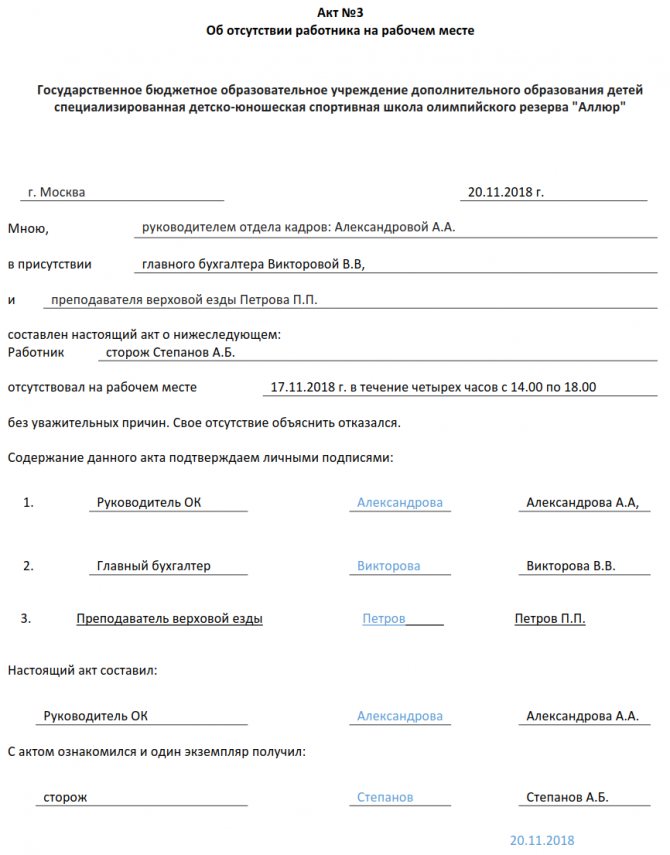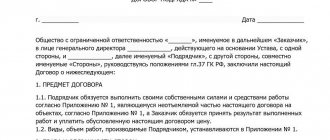What is an act and why is it needed?
An employee’s absence from work report is an up-to-date document required by the employer if an employee of an institution violates labor discipline, does not adhere to the norms and rules of the work schedule, or does not show up for work at all. This document gives the employer the opportunity to apply the types of disciplinary penalties established by labor legislation against the person - from reprimand to dismissal.
The truancy document records absence from work without good reason for more than 4 hours in a row. This is paper of any format, since there is no form approved by the legislator. At the same time, the document is important because it is the basis for disciplinary action.
After drawing up the act
In the future, if it turns out that the employee did not have valid reasons for absenteeism, these facts are recognized as absenteeism, which entails punishment through an order of disciplinary action, up to and including dismissal. If an employee, having appeared at work, provides the employer with written evidence of valid circumstances of absence from the workplace, then he is released from any liability and legally begins to perform his official duties.
This is also important to know:
Sample order to lift a disciplinary sanction: how to draw it up correctly
Employee absenteeism report.
Form of completion The Act of Absence from Work does not have a clearly regulated form. Let's consider the main provisions that must be indicated in the act.
- Full name and position of the person who compiled the act and witnesses to the violation;
- description of the violation, time period of the violation, full name of the violator;
- registration number, date and place of signing the act,
- details of the organization, signature of the head of the organization, the author of the act, witnesses and the employee of the violator.
If the violator himself does not want to sign the act drawn up, a corresponding note is made, next to which the drafters of the act sign.
When necessary
The document is generated even if there is a one-time offense in the form of absenteeism (paragraph “a”, paragraph 6 of Article 81 of the Labor Code of the Russian Federation). This means that the employee was not present at the workplace without a good reason:
- the entire work day (shift), regardless of its duration;
- four hours in a row during a work day (shift).
For example, an employee who visited without the employer’s permission and without recording an official doctor’s request for consultation and did not open a sick leave certificate will not have an easy time proving the valid reason for his absence from work for more than 4 hours in a row. An employee should not voluntarily go on vacation or arrange days off according to his personal desires (an exception in this case is, for example, donating blood when the employee was denied legal leave).
The current legislation can define a number of positions that do not qualify as absenteeism. These are:
- lack of ability to work, confirmed by sick leave (Article 81 of the Labor Code of the Russian Federation);
- the fact of involving a person in state or public duties (for example, a summons to law enforcement agencies) (Article 170 of the Labor Code of the Russian Federation);
- donation of donor blood (Article 186 of the Labor Code of the Russian Federation);
- arrest;
- circumstances of an emergency nature;
- invitation to participate in a strike (Article 414 of the Labor Code of the Russian Federation);
- suspension of labor activity due to non-payment of wages for a period of more than 15 days (Article 142 of the Labor Code of the Russian Federation).
Thus, if a person can prove the existence of these circumstances, he will not be held accountable in the form of dismissal, even if he has an act of absenteeism at work.
Valid reasons for absence that cannot be dismissed
A life situation may develop such that an employee is forced to be absent from the enterprise for reasons beyond his control. In this case, it is impossible to talk about absenteeism, and it will not be possible to fire him for such absence from work.
In this regard, having discovered the absence of a company employee, the person in charge must first try to contact him and find out all the circumstances and reasons for the employee’s failure to appear on site. In this case, you can use all available means of communication - telephone, telegram, letter, visiting his home.
The list of reasons that may be considered valid is not strictly fixed by law, they include:
- Donating blood as a donor;
- Illness or injury of an employee of the enterprise or members of his family;
- Fulfillment by a person working at an enterprise of civil or public duties in cases provided for by law (calling as a witness, juror, etc.);
- Vehicle accidents on the roads;
- Administrative opinion;
- Natural disasters and catastrophes;
- Late due to public transport delays.
- Stopping the performance of work duties by an employee due to non-payment of wages for more than six months with prior notification of the company management about this.
- An employee returning to work according to the old schedule, if he was not previously notified of this in writing with the obligatory affixing of a visa.
Attention! These reasons are considered valid, even in a situation where the employee was unable to report them to the personnel service or other responsible person in a timely manner. However, there is a legal requirement that requires that all these reasons be supported by relevant documents.
If the employee does not immediately submit them, the administration must independently request all these forms from him. Along with them, it is advisable for the employee to also provide written explanations for his absence within two days. Only then is the employee’s dismissal for absenteeism not formalized.
You might be interested in:
Dismissal for absenteeism in [year]: step-by-step procedure with sample documents
If an employee whom the administration trusts was absent from work, then the report need not be drawn up.
Form of the act
The document can be drawn up:
- on a regular A4 sheet;
- on the institution's letterhead.
For convenience, organizations are developing a template in which the necessary information will need to be entered. A possible version of the form and a sample employee absenteeism report (2018) can be downloaded below. Since there is no set form, the text is formed depending on the specific situation.
Mandatory registration requirements are:
- written form;
- Availability of details (date of formation, serial number);
- information about the employer;
- information about the absent employee indicating his full name. and positions;
- reason for absence;
- data of employees (full name, position) who executed and signed the document, certifying the actual absence of the person at work.
How to draw up an act of absence of an employee from the workplace
How to document an employee’s absenteeism sample 2021. An employee’s absenteeism report, the form of which does not have a unified form, but requires compliance with a number of requirements, is drawn up by a commission - the employee’s absence from the workplace must be recorded in the presence of at least two people. In addition, in order to avoid invalidation of the act, it must contain the following information:
- details of the commission members, as well as the employee who is absent from work (positions, surnames, initials);
- information on the measures taken to establish the location of the absent employee and the reasons for absenteeism, the results of such measures;
- the duration of the employee’s absence from the workplace with a note indicating the inclusion of lunch and other breaks during this time;
- place (settlement) and date of drawing up the act.
This is also important to know:
Who imposes a disciplinary sanction for violating sanitary legislation and what is the procedure for registration
The employee in respect of whom the act has been drawn up must be familiarized with it against receipt. In case of refusal to sign, a corresponding note is made in the act, certified by the members of the commission.
IMPORTANT! Refusal to sign does not prevent the imposition of a disciplinary sanction. Therefore, in case of disagreement with the contents of the document, it is better to record all objections and comments directly in the act itself.
Filling procedure
The question of who is obliged to draw up an act of truancy is not regulated at the legislative level. This means that the specific official who creates the document is not strictly defined. As a general practice, the paper can be drawn up by:
- the immediate supervisor of the absent employee;
- colleague;
- personnel worker;
- organization lawyer;
- secretary of the organization, etc.
The employee’s absence report from the place of work contains the following information:
- name of the institution, address of its location;
- Title of the document;
- registration number and date of formation;
- Full name, position of the person who executed the paper;
- Full name, positions of employees present in the compilation process;
- signatures of all specified persons indicating the fact of being away from the workplace;
- Full name, position of the absent employee;
- description of the situation related to the violation;
- indication of the duration of the employee’s absence.
The date of registration of the truancy report coincides with the date of the offense itself, that is, the document must be drawn up based on the fact of the violation.
The form must be signed by at least two witnesses. This means that the document is signed by both its immediate compiler and at least two more colleagues. In this case, during the trial, the document will have greater legal significance.
An employee who has received a disciplinary sanction based on the materials of the report may disagree and send a statement of claim to the court, challenging the fact of absenteeism. In this case, if the act is drawn up with violations, the penalty may be canceled. Another reason why a document may lose its validity is if the employee proves that the reason for absence is valid.
Common mistakes when drawing up an act are:
- there is no indication of the period of absence (time of departure, arrival);
- no date of absence;
- There are no witness signatures.

The need to record a violation
Any violations of labor discipline must be documented if the employer wishes to respond to this act. The lack of paperwork does not allow penalties to be applied to the culprit. Moreover, the papers must be recorded and executed within a strictly established time frame; skipping them will also not allow the offender to be punished.
This is also important to know:
How to write a statement to the prosecutor’s office: examples and samples
The employer is obliged to carry out the following steps step by step:
- On the day of absence from work, after four hours or earlier, draw up an employee absence report. By itself, it does not entail any penalties.
- After the employee appears, obtain a written explanatory note from him, in which he will explain the reasons for his behavior and absenteeism. An explanation is written if there are no documentary reasons for failure to appear.
- If the truant refuses to give an explanation for his actions, then the refusal is recorded in another act.
- An order is issued to impose penalties on the employee.
Based on the act and the explanatory note from the employee himself, a decision is made on the punishment.
The management of the organization has the right to react differently to absenteeism, even to the point of simply leaving this fact unattended.
The Labor Code establishes that when determining a punitive action, it is necessary to weigh the severity of the offense itself and the penalty applied. So, a person cannot be fired for being late, but for absenteeism, the employer has the right to use extreme measures, but also has the right to mitigate the punishment to a reprimand or warning.








